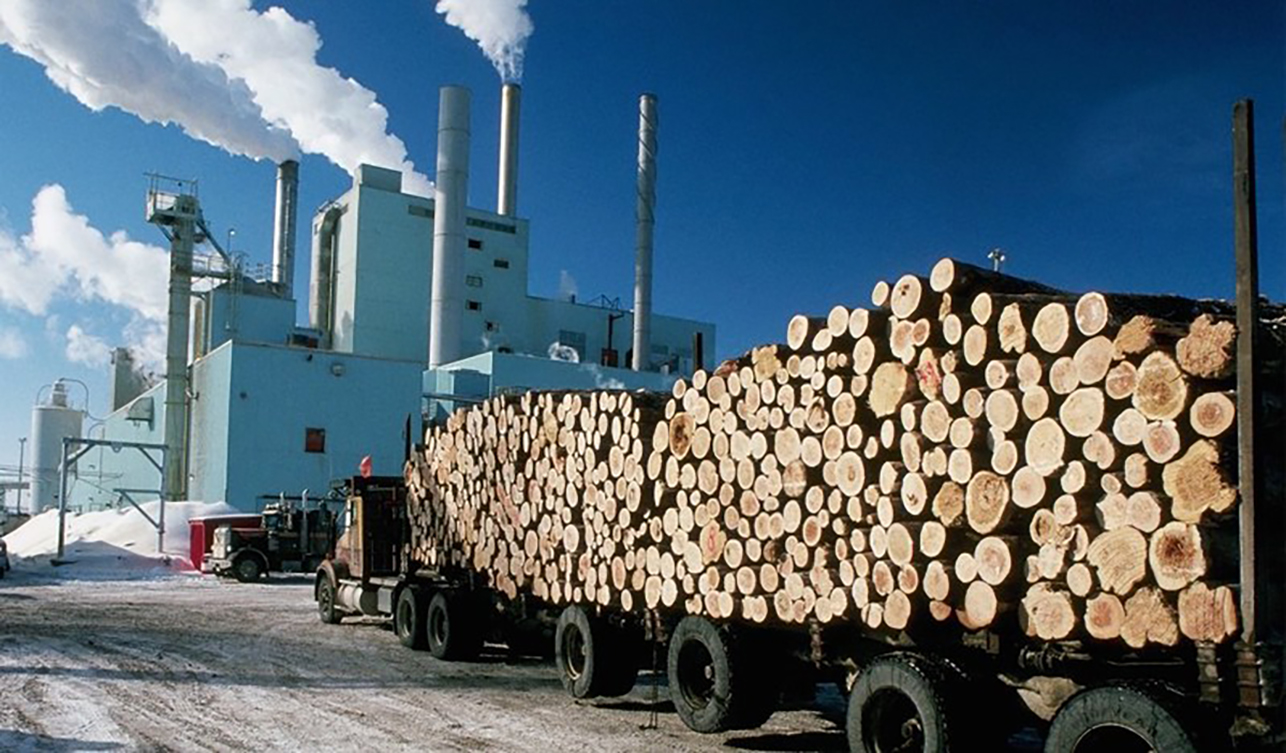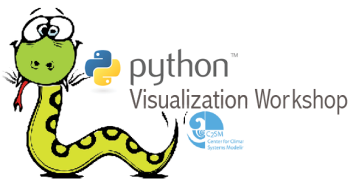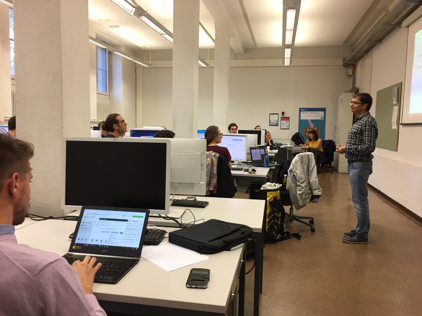C2SM Newsletter vol. 28
Download newsletter as Downloadpdf (PDF, 777 KB)vertical_align_bottom.
Topics in this Newsletter - April 2019
- News from the Steering Committee
- Global modelling activities
- Regional modelling activities
- Scientific visualization activities
- Python workshops 2019
- Data Management Workshop: Best Practices
- News from C2SM groups
- News from MeteoSwiss
- News from Empa
- News from WSL
- Selected press articles
- Article: C2SM scientists actively involved in Scientists for Future
- PhD defenses in the C2SM community
- Upcoming events of interest
- Paper: The importance of mixed-phase and ice clouds for climate sensitivity in the global aerosol-climate model ECHAM6-HAM2
- Paper: Accounting for the vertical distribution of emissions in atmospheric CO2 simulations
- Paper: The oceanic sink for anthropogenic CO2 from 1994 to 2007
- Paper: Nonlinearity in the North Pacific atmospheric response to a linear ENSO forcing
- Papers: Intense precipitation case studies with the COSMO-E ensemble
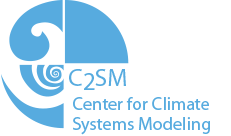
News from the Steering Committee
We regularly include information from the Steering Committee (SC) meetings and about the decisions that have been taken.
C2SM successfully acquires resources for EULER computing nodes
In September 2018, C2SM submitted a proposal to ETH’s scientific equipment program (SEP) for funding a share of the EULER computer cluster at ETH. The proposal was a joint application from eight C2SM members from D-USYS with the aim to renew and expand their previous shares on EULER. In November 2018, the school board principally granted the proposal, and in March 2019, it approved the amount of the support, which amounts to a little less than a million Swiss Francs, half of the sum that is needed to acquire the nodes. The remaining resources are provided by the individual groups; another significant amount has been granted from Climate-KIC reserves.
Status update external evaluation of C2SM
The current third phase of funding of C2SM will end in December 2020. As a preparational measure for ETH school board to decide on whether and how to continue C2SM after 2020, it requested for an external evaluation of C2SM to take place in 2019. This evaluation will take place on 20 August 2019. A committee of four renowned national and international scientists from the field has been set up on this occasion, which will be chaired by the director of Max-Planck Institute for Meteorology and chair of C2SM’s scientific advisory board, Bjorn Stevens. The preparations for the evaluation are ongoing, and C2SM members have jointly been working on a self-evaluation report and business plan in the last months as a basis for this evaluation.

Note on the Swiss Climate Summer School 2019: “Carbon and climate in a 2° world: getting out of the fossil fuel carbon budget crunch”
Klimarunde 2019 – save the date!
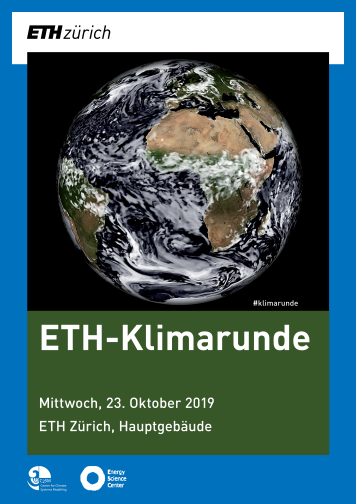
This year’s Klimarunde will take place on Wednesday, 23 October 2019, and will cover the theme “Climate change in mountain regions”. Preparations have started, and an organization committee has been set up to prepare the details of the event. This committee includes C2SM members from ETH and MeteoSwiss as well as member of the Energy Science Center (ESC). Please save the date in your agendas!

Global modelling activities
Recent activities from the global climate modelling group included the preparation of emission files for the participation of the ECHAM-HAMMOZ consortium in the AerChemMIP initiative. In addition, C2SM supported its GCM groups in the installation of different ICON versions on CSCS computers. Furthermore, we provided support for the technical part of the proposal for a production project at CSCS submitted by the C2SM members Ulrike Lohmann, Martin Wild, and Daniela Domeisen. Besides, C2SM organized three ICON meetings for its community members. The C2SM-ICON meetings are announced via a mailing list. If you wish to subscribe, please send a short email to
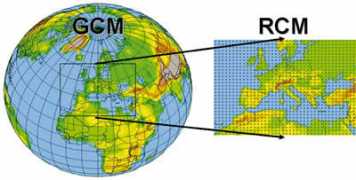
Regional modelling activities
Recent regional modelling activities include finalizing a major release of the EXTPAR software to make it fully compatible with the current COSMO and ICON versions (v5.0). Additionally, the M7 addition to the ART aerosol model, which was developed during the PhD work of Franziska Glassmeier in the group of Ulrike Lohmann, has been ported into the official ART code and is now regularly maintained and fully compatible with the latest version of the COSMO model. Finally, the COSMO User Workshop was held in January 2019 at ETH Zürich. The almost 50 attendees represented many of C2SM's member institutions including ETH Zürich, EMPA, MeteoSwiss, and WSL.
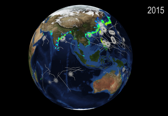
Scientific visualization activities
First and foremost, we are pleased to announce that C2SM has started its own external pageVimeo channelcall_made. In future, we plan to release most of our animations on it.
Another exciting news is that we have set up a new Web Map Service (WMS) server (presently for internal use only). This server allows us to map and display raster and vector data on WMS clients such as map.geo.admin.ch.
This server was used to overlay rendered images of heat days on to the 3D Swiss topography provided by Swiss Topo (map.geo.admin.ch). We have also developed (and are further developing) scripts which enable us to record animations using the above-mentioned setup. external pageOne such animation was created for the Swiss Climate Scenarios project (CH2018).call_made
We have also worked on the WMS setup to display "Query on Click", which means that it can overlay vector data objects such as points on a map and return some information when these objects are clicked on using a mouse. This part is still in a preliminary phase.
For the CH2018 project, we have also created a stand-alone animation of temperature anomalies combining the past observations and future simulated data. This animation will be released very soon on our Vimeo channel.
Currently, we are working on another exciting project wherein we are creating animations for the external pageSmartCarb projectcall_made. This animation is envisioned to contain elements showing global ECMWF data, regional COSMO data and satellite tracks.
Sharing and collaboration: C2SM has decided to host data-processing and visualization tool/script repositories on the C2SM GitHub. There are a lot of useful tools being developed within the C2Sm community, and this GitHub aims at providing a common platform to all the members to benefit from each other's developments, foster co-development of tools and potentially prevent any re-inventing of wheels. If you are interested in sharing your software tools with the wider C2SM community via the C2SM GitHub or have any question regarding it, please get in touch with .
As communicated previously, apart from working on longer directly paid projects, we continue to provide free-of-charge short duration (up to 2 days) visualization support to individual researchers. Therefore, if you have any questions or require support, feel free to contact
For more information on our activities and recent animations, please visit our scientific visualization page.
This introductory workshop is recommended as a preparatory step for members interested in joining for the visualization workshop but do not know Python Programming at all. Please visit the our webpage on details of the courses.

Data Management Workshop: Best Practices
On 7 March 2019, C2SM’s task force on Data Management carried out a workshop on the topic of best practices in data management. This workshop especially targeted Master and PhD students of C2SM’s D-USYS members. Besides an introduction given by U. Beyerle, it covered the topics: 1) how to manage data during the PhD giving lots of examples how not to do it (by M. Sprenger); 2) data workflow: from raw data to archiving including explanations of the FAIR principles, recommendations for formats and coding, and data repositories (by S. Ferrachat), and 3) finally introductory overview on the version control system Git, which included a concrete application example (C. Siegenthaler).
With 41 registrations, the course was well-attended. A feedback survey showed that in general, the workshop was perceived well and expectations were met to a large extent. The data management task force will now evaluate the feedback survey in detail and consider how to refine the workshop in the future.
For more information and the presentations of the workshop, please see the C2SM data management wiki.

News from C2SM groups
News from Daniela Domeisen’s group:
Daniela’s group has received funding for a grant from the Swiss Data Science Center, a collaboration between IAC (Daniela Domeisen, Will Ball) and the ETH Department of Computer Science. The project will deal with the predictability of the stratosphere on sub-seasonal to seasonal timescales, the teleconnections involved, and the downward impacts of the stratosphere using machine learning methods. The project will also include the visualization of the stratospheric flow.
Daniela is currently looking for a candidate for the 2-year Postdoc position in her group in the Institute for Atmospheric and Climate Science at ETH. Please contact if you are interested.
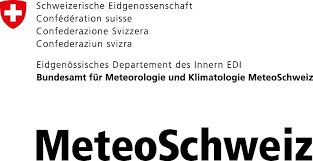
News from MeteoSwiss
Climate change and winter sports
MeteoSwiss (Sven Kotlarski) and colleagues from the WSL Institute for Snow and Avalanche Research SLF represented Switzerland in an expert panel discussing the implications of future climate change for winter sports and winter tourism in the Alps. Organized by the German “Stiftung Sicherheit im Skisport” (SIS) the expert group also included the German (DWD) and Austrian (ZAMG) national meteorological services, as well as tourism boards and representatives of ski resort operators. Two meetings in October 2018 and January 2019 resulted in a summary document that outlines the main findings regarding future Alpine climate change and its consequences for winter sports and tourism. The document was covered by a range of media contributions in Germany, Austria and Switzerland and is available on external pagehttp://www.stiftung.skicall_made. The projected warming in the Alps will lead to an important decline of snowfall and natural snow cover, and will also limit potential time windows for the production of technical snow. As a consequence, winter sports and winter tourism will be forced to further develop and to adapt to these new conditions, which bears a chance for a transition to more sustainable winter tourism concepts.
A dedicated MeteoSwiss blog is available at the external pageMeteoSwiss webpage.call_made

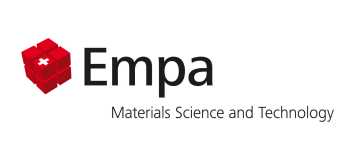
News from Empa
C2SM member Dominik Brunner and coauthors have recently published the first paper using the GPU accelerated version of COSMO to simulate the atmospheric transport of CO2 in the atmosphere entitled “Accounting for the vertical distribution of emissions in atmospheric CO2 simulations”. For details please see the paper section.
Important new funding: The ESA funded project external pageSMARTCARBcall_made, which investigates the potential of a future constellation of CO2 satellites to quantify anthropogenic emissions received an extension for another year.

News from WSL
CHELSA – Free climate data for impact studies at high resolution
CHELSA (Climatologies at high resolution for the earth’s land surface areas) is a high-resolution climate data set for the global land surface area. It is hosted by the Swiss Federal Institute for Forest, Snow and Landscape Research WSL. The temperature and precipitation data help to model living conditions of species.
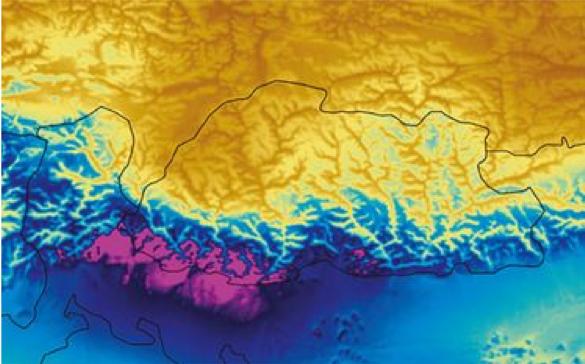
In order to be able to study living organisms, ecologists need the most precise data possible on the climatic conditions. From the temporal and spatial distribution of temperature and precipitation, they can calculate local habitats (niches), vegetation periods, or the distribution of animal and plant species. Small errors in the climate models can quickly lead to large deviations in such models, which makes it difficult to investigate ecological changes.
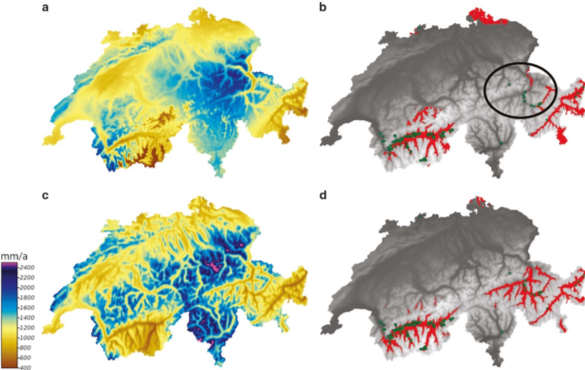
An improvement of climate information is therefore desirable. Especially for regions with a low density of meteorological stations as mountains or remote rainforests. With CHELSA, WSL researchers and colleagues now offer a solution that has quickly become popular among ecologists, as is demonstrated by a steadily increasing number of downloads and publications using the data.
CHELSA solves the problem of unequal distribution of meteorological stations by mechanistically downscaling global reanalysis data from corse to fine resolution (to 30 arc sec., approx. 1 km2 grid size). Thus, the model provides worldwide, monthly time series for temperatures and precipitation. The model is now also applied to daily timeseries (MERRA2 reanalysis) future climate change scenarios (CMIP5) providing data until 2100 (based on CMIP5 models), and paleo climate models for last 21’000 years (based on PMIP3 and CCSM-TraCE).
Tests show that CHELSA generates more reliable patterns of climate data than the previously used interpolations based on climate station data - especially in mountainous regions and in areas with low station density (see publication). In particular, precipitation patterns are better predicted compared to other models.
For inquiries please contact Dr. Dirk N. Karger, Swiss Federal Research Institute WSL, Zürcherstrasse 111, 8903 Birmensdorf, Switzerland, or Prof. Dr. Niklaus E. Zimmermann
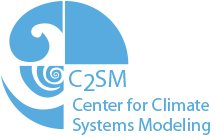
Selected press articles
- Neue Zürcher Zeitung (NZZ): external page"Alles eine Erfindung der Klimalobby!"call_made (Article by Gabriela Dettwiler mit Beiträgen von Nicolas Gruber & Stefan Brönnimann), April 2019
- Tagesanzeiger: external page„Der Winter macht was er will”call_made (Article by Martin Läubli, ABO) (Daniela & Reto), March 2019
- Spektrum der Wissenschaft: external page„Wetter: Frühling schon im Februar”call_made (Article by Andreas Frey), February 2019
- ETH News: „Warming in the stratosphere leads to cold winters” (Interview by Peter Rüegg), January 2019
- Neue Zürcher Zeitung (NZZ): external page„Ein Kollaps des Polarwirbels bringt den USA arktische Kälte”call_made (Article by Christian Speicher), January 2019
- Frankfurter Sonntagszeitung: external page„Am Ursprung der Kälte”call_made (Article by Andreas Frey), January 2019
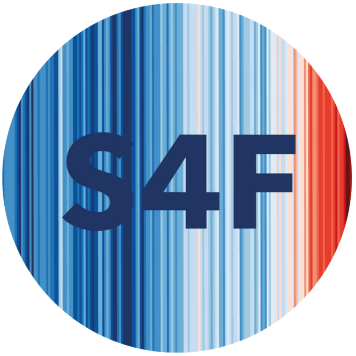
Note: C2SM scientists support Scientists for Future
More than 26'800 climate, sustainability, biodiversity, and transformation scientists from Germany, Austria, and Switzerland support the request of the climate striking students in signing a petition entitled “Scientists for Future”. In Switzerland alone, 2773 scientists signed the petition, among them a majority of the C2SM members. According to the petition which was published on 14 March 2019, the current measures on climate mitigation, protection of species, forest, ocean and soils are by far not sufficient.
“The young people rightly demand that our society gears towards sustainability without hesitation. Without profound and consequent change their future is endangered”, the petition writes. “Climate friendly and sustainable action has to become simple and cheap. In contrast, climate damaging action must become unattractive and expensive.”
C2SM member Sonia Seneviratne adds: «Children who are now 10 years old, will be 30 to 40 years old when we will have reduced the emissions of greenhouse gases to zero to avoid a warming larger than 1.5°C. That’s why people who are teenagers now will have to live with the consequences of our action or inaction.” And C2SM member Reto Knutti states: “Climate change is real, human caused, and the impacts are already visible today. Current climate politics is insufficient to achieve the global aims of the Paris Agreement”. This is why Reto is not surprised that so many researchers have signed the petition within a few days.
The above text is a translated and adapted excerpt of the external pageProClim press releasecall_made from 14 March 2019.
An international version of the petition has been initiated by an international group of renowned climate scientists, among them C2SM members Reto Knutti and Sonia Seneviratne, and has been published as a Letter to Science: external page“Concerns of Protesters are justified”call_made on 11 April 2019. It includes a list of the initial signatories in the Supplement Material. It is still possible to sign this petition external pageherecall_made.
external pageLink to Scientists for Future webpagecall_made

PhD Defenses in the C2SM community
We congratulate our community members for their successfully completed PhDs!
Kathrin Fuchs: Mitigation of Greenhouse Gas Emissions from Intensively Managed Grassland, ETH Zurich, 27 September 2018
Stefan Rüdisühli: Attribution of rain to cyclones and fronts over Europe in a kilometer-scale regional climate simulation, ETH Zurich, 18 Oct 2018.
Marco Vanoni: Forest dynamics in Swiss forest reserves: impact of climate extremes on tree growth prior to mortality and projections of forest succession. ETH Zurich, 23 October 2018
Martha-Marie Vogel: Temperature extremes in a changing climate - Processes, emergent constraints and impacts, 5 December 2018
Simon Knüsel: Tree of heaven or hell? On the ecology of Ailanthus altissima (Mill.) Swingle. ETH Zurich, 14 December 2018.
Anina Gilgen: Aerosol-cloud interactions: from the future to the past, ETH Zurich, 17 December 2018
Heewon Moon: Precipitation and drought persistence in global climate models and observations, ETH Zurich, 18 March 2019

Upcoming events of interest
C2SM events 2019:
May 13, 2019: Introductory course in python.
June 18-19, 2019: Scientific visualization in python course.
September 8-13, 2019: Swiss Climate Summer School 2019.
October 23, 2019: Klimarunde 2019 on climate change in mountain regions. Please save the date!
Other events of interest:
June 12-14, 2019: PASC19 conference on scientific computing and computational science, Zurich, Switzerland
August 21-23, 2019: Latsis Symposium on “High-Resolution Climate Modeling: Perspectives and Challenges”
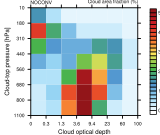
Paper: The importance of mixed-phase and ice clouds for climate sensitivity in the global aerosol-climate model ECHAM6-HAM2
How clouds change in a warmer climate remains one of the largest uncertainties for the equilibrium climate sensitivity (ECS). While a large spread in the cloud feed- back arises from low-level clouds, it was recently shown that mixed-phase clouds are also important for ECS. If mixed-phase clouds in the current climate contain too few super-cooled cloud droplets, too much ice will change to liquid water in a warmer climate. As shown by Tan et al. (2016),this overestimates the negative cloud-phase feedback and underestimates ECS in the CAM global climate model (GCM). Here we use the newest version of the ECHAM6-HAM2 GCM to investigate the importance of mixed-phase and ice clouds for ECS. Although we also considerably underestimate the fraction of supercooled liquid water globally in the reference version of the ECHAM6-HAM2 GCM, we do not obtain increases in ECS in simulations with more supercooled liquid water in the present-day climate, different from the findings by Tan et al. (2016). We hypothesize that it is not the global supercooled liquid water fraction that matters, but only how well low- and mid-level mixed-phase clouds with cloud-top temperatures in the mixed-phase temperature range between 0 and −35°C that are not shielded by higher-lying ice clouds are simulated. These occur most frequently in midlatitudes, in particular over the Southern Ocean where they determine the amount of absorbed shortwave radiation. In ECHAM6-HAM2 the amount of absorbed shortwave radiation over the Southern Ocean is only significantly overestimated if all clouds below 0°C consist exclusively of ice. Only in this simulation is ECS significantly smaller than in all other simulations and the cloud optical depth feedback is the dominant cloud feedback. In all other simulations, the cloud optical depth feedback is weak and changes in cloud feedbacks associated with cloud amount and cloud-top pressure dominate the overall cloud feedback. However, apart from the simulation with only ice below 0°C, differences in the overall cloud feedback are not translated into differences in ECS in our model. This insensitivity to the cloud feedback in our model is explained with compensating effects in the clear sky.
Lohmann, U. and Neubauer, D., 2018: The importance of mixed-phase and ice clouds for climate sensitivity in the global aerosol–climate model ECHAM6-HAM2, Atmos. Chem. Phys., 18, 8807-8828, external pagedoi.org/10.5194/acp-18-8807-2018.call_made
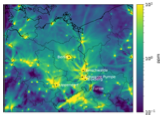
Paper: Accounting for the vertical distribution of emissions in atmospheric CO2 simulations
Inverse modeling of anthropogenic and biospheric CO2 fluxes from ground-based and satellite observations critically depends on the accuracy of atmospheric transport simulations. Previous studies emphasized the impact of errors in simulated winds and vertical mixing in the planetary boundary layer, whereas the potential importance of releasing emissions not only at the surface but distributing them in the vertical was largely neglected. Accounting for elevated emissions may be critical, since more than 50 % of CO2 in Europe is emitted by large point sources such as power plants and industrial facilities. In this study, we conduct high-resolution atmospheric simulations of CO2 with the mesoscale Consortium for Small-scale Modeling model extended with a module for the simulation of greenhouse gases (COSMO-GHG) over a domain covering the city of Berlin and several coal-fired power plants in eastern Germany, Poland and Czech Republic. By including separate tracers for anthropogenic CO2 emitted only at the surface or according to realistic, source-dependent profiles, we find that releasing CO2 only at the surface overestimates near-surface CO2 concentrations in the afternoon on average by 14 % in summer and 43 % in winter over the selected model domain. Differences in column-averaged dry air mole XCO2 fractions are smaller, between 5 % in winter and 8 % in summer, suggesting smaller yet non-negligible sensitivities for inversion modeling studies assimilating satellite rather than surface observations. The results suggest that the traditional approach of emitting CO2 only at the surface is problematic and that a proper allocation of emissions in the vertical deserves as much attention as an accurate simulation of atmospheric transport.
Brunner, D., Kuhlmann, G., Marshall, J., Clément, V., Fuhrer, O., Broquet, G., Löscher, A., and Meijer, Y., 2019: Accounting for the vertical distribution of emissions in atmospheric CO2 simulations, Atmos. Chem. Phys., 19, 4541-4559, external pagedoi.org/10.5194/acp-19-4541-2019.call_made
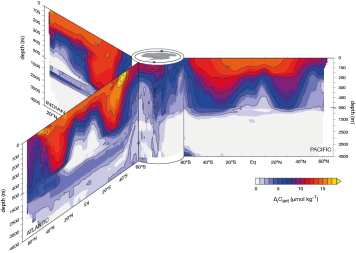
Paper: The oceanic sink for anthropogenic CO2 from 1994 to 2007
We quantify the oceanic sink for anthropogenic carbon dioxide (CO2) over the period 1994 to 2007 by using observations from the global repeat hydrography program and contrasting them to observations from the 1990s. Using a linear regression–based method, we find a global increase in the anthropogenic CO2 inventory of 34 ± 4 petagrams of carbon (Pg C) between 1994 and 2007. This is equivalent to an average uptake rate of 2.6 ± 0.3 Pg C year−1 and represents 31 ± 4% of the global anthropogenic CO2 emissions over this period. Although this global ocean sink estimate is consistent with the expectation of the ocean uptake having increased in proportion to the rise in atmospheric CO2, substantial regional differences in storage rate are found, likely owing to climate variability–driven changes in ocean circulation.
Gruber, N. et al, 2019: The oceanic sink for anthropogenic CO2 from 1994 to 2007. Science, external pagedoi:10.1126/science.aau5153call_made
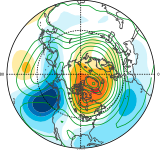
Paper: Nonlinearity in the North Pacific atmospheric response to a linear ENSO forcing
El Niño Southern Oscillation (ENSO) is an atmosphere‐ocean coupled phenomenon in the tropical Pacific. Sea surface temperatures (SST) oscillate between a warm phase (El Niño) and a cold phase (La Niña). Anomalous SSTs are linked to changes in tropical rainfall, leading to a global influence. One of the most prominent influences takes place during Northern Hemisphere winter in the North Pacific and North America. However, each ENSO event is intrinsically different, and so are its impacts. Differences in the impacts can arise from differences in the exact location and strength of the SST anomalies in the tropics. To separate these factors, we use an atmospheric model and prescribe seasonally varying SSTs with linearly varying strength at a fixed location. Whereas for moderate events the impacts in the North Pacific are more linear (El Niño and La Niña have similar but opposite impacts), strong events exhibit significant nonlinearity (strong ENSO events yield more than twice the impact, especially for El Niño). The nonlinearity can be traced back to the relationship between SST and tropical rainfall. Our results have important implications for projected changes in the ENSO characteristics with climate change, which could nonlinearly impact the remote effects of ENSO.
Jiménez-Esteve, B. and Domeisen, D.I.V., 2019: Nonlinearity in the North Pacific atmospheric response to a linear ENSO forcing, Geophys. Res. Lett., external pagedoi.org/10.1029/2018GL081226.call_made
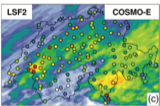
Papers: Intense precipitation case studies with the COSMO-E ensemble
Two publications present detailed results about the performance of the operational convection-resolving ensemble prediction system of MeteoSwiss (COSMO-E) for three contrasting precipitation events in Switzerland. The events include locally triggered air-mass convection on four consecutive days, a complex flood-producing rainfall episode, and a summertime cold-frontal precipitation event. In terms of the precipitation pattern, COSMO-E outperforms the driving ECMWF ensemble in all cases. The higher resolution of COSMO-E leads to increased spread and reduced underdispersion for near-surface variables. However, for both events with large-scale advection, underdispersion occurs for mid-tropospheric relative humidity near fronts also in COSMO-E. In the second study, a detailed investigation of the growth of ensemble variance of the horizontal wind reveals that ensemble variance increases in the presence of moist convective activity or strong synoptic-scale forcing, and stagnates or decreases otherwise, rendering forecasts of convection- permitting ensembles valuable beyond the very short forecast range.
Klasa, C., Arpagaus, M., Walser, A., and Wernli, H., 2018: An evaluation of the convection-permitting ensemble COSMO-E for three contrasting precipitation events in Switzerland, Quart. J. Roy. Meteorol. Soc., 144, 744–764.
Klasa, C., Arpagaus, M., Walser, A., and Wernli, H., 2019: On the time evolution of limited-area ensemble variance: Case studies with the convection-permitting ensemble COSMO-E, J. Atmos. Sci., 76, 11–26.

